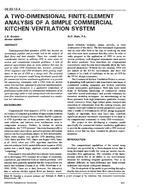Description
Computational fluid dynamics (CFD) has become an increasingly popular and powerful tool in the analysis of fluid flows and heat transfer. There has recently been considerable interest in utilising CFD to solve room air motion and contaminant transport problems. A lack of physical experimental data on room air flows that may be used to verify CFD simulations has, however, prevented HVAC engineers and CFD developers from gathering confidence in the use of CFD as a design tool. The principal objective of a computer model being developed specifically for commercial kitchen ventilation application is to provide the engineering community with a CFD room air motion solver that has been validated by physical experimentation. The following discussion is a qualitative comparison of preliminary results from two-dimensional simulations of an open-top range under a wall canopy hood with observations from flow visualisation experiments conducted in a ventilation test laboratory.
KEYWORDS: commercial, kitchens, ventilation, computers, calculating, fluid flow, heat flow, rooms, air movement, contaminants, models, comparing, exhaust hoods, range boilers.
Citation: Symposium, ASHRAE Trans., 1993, vol.99, part 2, paper number DE-93-1-1, 429-439, 7 figs, 2 tabs, refs.
Product Details
- Published:
- 1993
- File Size:
- 1 file , 1.4 MB
- Product Code(s):
- D-17535




